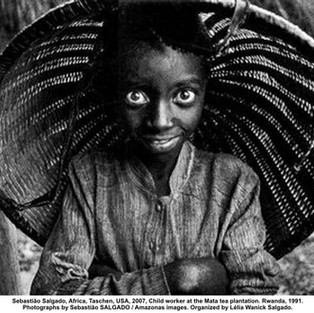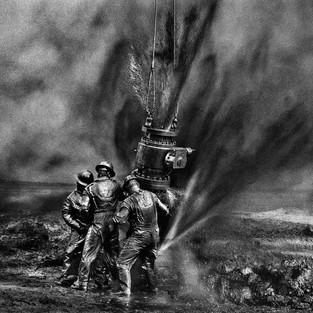SEBASTIAO SALGADO
- Gisella Burga
- Aug 6, 2024
- 8 min read
One of the most important photographers of the world.

Talk about Sebastiao Salgado is talk about a whole life dedicated to photography, traveling around the world living with different cultures to get to know them, understand them, and then show us it through his lens.
His work is immense and really impressive. Thanks to the documentary” The Salt of the Earth” directed by Wim Wenders and Jiuliano Ribero Salgado, we can get an idea of how has been his life and work of this magnificent photographer.
He studied Economy at the University of Sao Paulo. When he met Lelia Wanik, he will not only know the love of his life but also the partner who will help him develop all his photographic projects. They had to leave Brazil and immigrated to France, going away from the military dictatorship that was ravaging their country. In Paris, Sebastiao did a PhD in the National School of Economic Statistic and Lelia studied architecture and, as she had to take pictures of the buildings to study them, she bought a camera.
His work at the International Coffee Organization in London required him to make frequent trips to Africa and, and every time he took with him the photographic camera of Lelia. Here he began his passion for photography, so it is that that he left his job as an economist to dedicate himself professionally as a photographer, traveling around the world documenting what he saw and working for different agencies until 1979 when he joined the prestigious International photography cooperative Magnum, founded in 1947 by Cartier-Bresson, Robert Capa, George Rodger and David Seymour.
His first major photographic project was called “Other Americas”, an eight-year journey through Ecuador, Peru, Bolivia and México during the years 1977-1984. These trips will take him to know and live with different indigenous communities, such as the Saraguros in the south of Ecuador, of whom he said: “Never before I had seen a whole community with another rhythm, everything was slow, it was another way of thinking, another speed”.
He also lived with the Mixes in Oaxaca (México): “It was people who adored music, there those who knew how to play an instrument, they did not need to work because they worked as musicians”; and with the Tarahumaras in northern Mexico: “It was a hell follow these Indians because they did not walk, they flew”, making reference to that this people is known for its ability to run, such is it that they are known as “rarámuri” which means “the one with the light feet”.
During these years he also toured his own country, especially to know that other reality of the landless peasants. “In Brazil we still having a great movement of landless peasants, they are people of great moral and physical strength, despite being very fragile because they feed very badly. We have a part of the Sahel here in Brazil”. During the documentary “The salt of the earth”, Sebastiao talks about the importance of portraiture. “The strength of a portrait is so powerful that in a fraction of a second we understand a little of the life of the person we are photographing, the eyes say a lot, the expression of the face. When we take a picture, it is not only you who is making the photo, is people who offer you the photo”.
During the years 1984 to 1986 he worked for “Doctors without borders” in Ethiopia and the Sahel documenting the catastrophic effects of the drought that caused the death of almost a million people. With this photograph he made the book “Sahel: L’homme en Detresse”. His wife Lélia was in charge of the publication of the book and organized the exhibition to draw the attention of the world on the dramatic situation of this population.
During the years 1986 to 1991 he made “Workers”. Salgado wanted to made a tribute to “all those who built our world”.
To carry out this magnificent work, he travelled through 30 countries to portray, always in black and white, the deep changes that were taking place at this time and where the main characters are those men, women and working children who bear the burden of the industrialised world, who left the skin and their life’s for a miserable salaries and where often they can not even afford to buy the products that they have already produced.
“I wanted to provoke a debate about working conditions in the third world because these people work hard and do not receive the minimum necessary for their survival”.
There is a very interesting documentary made by the BBC about his Salgado’s job. The photographer talks about the ideas he had when he conceived this project: “When I began to see the increasing number of workers who lost their job, and as some industrial sectors began to disappear by modernising, and adapting to other means of production, I though it was already time to do a story about those great changes that were taking place around the world”.
The photo-book made for “Workers” is divided into six categories: agriculture, food, mining, industry, oil and construction.
The playwright, and screenwriter Arthur Miller wrote about this book: “Salgado reveals the pain, beauty and brutality of the working world on which everything is based”.
Salgado remember how de made these photographs in Kuwait: “In 1991, when the First Gulf War ended, the Iraqi troops withdrew and Sadam Hussein set fire to thousands of oil wells where thousands of fire-fighters from all over the world came. I knew I had to go to that part of the world. The smoke was so dense that the sun did not pass…sometimes it was night 24 hours. After the fire was turned off, the earth was so hot that there was danger of being turned on again. The noise was deafening, my deafness began then”.
Lisa Hostetler, of the International Photography Centre of NY said about Salgado’s work: “Sebastiao Salgado’s straightforward photographs portrays individuals living in desperate economic circumstances. Because he insists on presenting his pictures in series, rather than individually, and because each work’s point of view refuses to separate subject from context, Salgado achieve a difficult task”.
Sebastiao: “The photographs that I take, the social and human photography, are not taken in order to produce beautiful individual piece of art. I always present a sequence of images. In the exhibition there is a lot of literature, 25 large posters full of explanations and in the book each story is told in a journalistic way”.
In the BBC’s documentary he talks about his method of work and the tools he uses to build his stories: “I usually use these three cameras, the reflex 28, the Leica M with a 35mm lens and another Leica reflex with 60mm which is a macro lens. I always use another lens. Although I do not use it too much, I always wear it. It is a zoom that I use when I can not get close to my subject…I know that when I use the zoom is because I am not completely in the picture, I’m completely out of it, I have not gotten inside the photo, I’m not enough in focus”.
“You have to know something about the person you are going to photograph to built something. Because it seems to me that it is very difficult to arrive and take good photos, with strength, message if you just arrive and leave. It took me six years to finish this project”.
The book and the following exhibition were very successful; they served to strengthen Salgado’s reputation as one of the best documentary photographers of our time.
His next project was magnificent. He documented the great migrations of people all over the world, people displaced by the wars and the hunger that existed in their own countries. With Lélia they began to plan “Éxodus”, and during the years that go from 1993 to 1999 Sebastiao travelled over the world to capture the darkest moments of humanity in the 20thcentury as the genocide of Rwanda, the Sub-Saharan Africans trying to reach the European coast by boats or those displaced by the Yugoslav war. “Our history is a history of wars, it is a story without end, a history of repression, a history of crazy people”.
In the “Salt of the earth” Salgado talks about this difficult stage: “In Rwanda people fled everywhere because of the repression against the Tutsis, the roads were full of people who fled with what the could. There were a los to death people on the roads. Two million people settled in a field. It was a catastrophe, cholera spread quickly and people die every day”.
Looking at these pictures I can not even imagine how horrible it must be to live with the despair of these people, to see them suffer like this and to continue doing my job. The photographer said that these were the worst moments of his professional career: “I left there, we did not deserve to live after that, I did not believe in anything anymore”.
Years later, in TED, the photographer gave a talk. He talked about the psychological damage that this experience caused him:“I saw in Ruanda the total brutality. I saw deaths by thousands per day. I lost my faith in our species. I didn’t believe that it was possible for us to live any longer and I started to be attacked by my own Staphylococcus. I started to have infection everywhere. When I made love with my wife I had no sperm that came out of me, I had blood. I went to see a friend’s doctor in Paris; I told him that I was completely sick. He made a long examination, and told me: “Sebastian you are not sick, your prostate is perfect. What happened is, you saw so many deaths that you are dying. You must stop. Stop. And I made the decision to stop. I was really upset with photography, with everything in the world, and I made the decision to go back to where I was born”.
His country was the refuge that the photographer needed to heal him, and Lélia’s support was the key to turning his life and photographic work around 360 degrees. They returned to the land of his parents, lands that were also dying because of the aridity. “When I was a child, more than 50% was tropical forest…we destroyed much of our forest to develop ourselves, and Lélia had an incredible idea: to reforest these lands as they were in the past. The first year we planted hundreds of threes and slowly, slowly, this dead land started to be born again…We created an institution called Instituto Terra”.
After some years working on his new environmental project, the photographer came back to dream with photography again. But this time to document our origins: “All my life I was photographing one animal: us and I wished to photograph the other animals, to photograph the landscapes, to photograph us, but us from the beginning, from the time we lived in equilibrium with the nature. And I started in the beginning of 2004 and I finish at the end of 2011.
And this new project was called “Genesis”, and it is one of the most beautiful photographic works I’ve ever seen in my life. 245 images that show the most beautiful thing we have on our planet: animals, forest, landscapes and indigenous communities that are still living in harmony with nature, completely away of the corruption of “modern life” as the origins of our time.
References:
Documentary “The Salt of the earth” (Spanish version)
BBC Documentary “Workers”
Sebastiao Salgado in TED






















































Comments